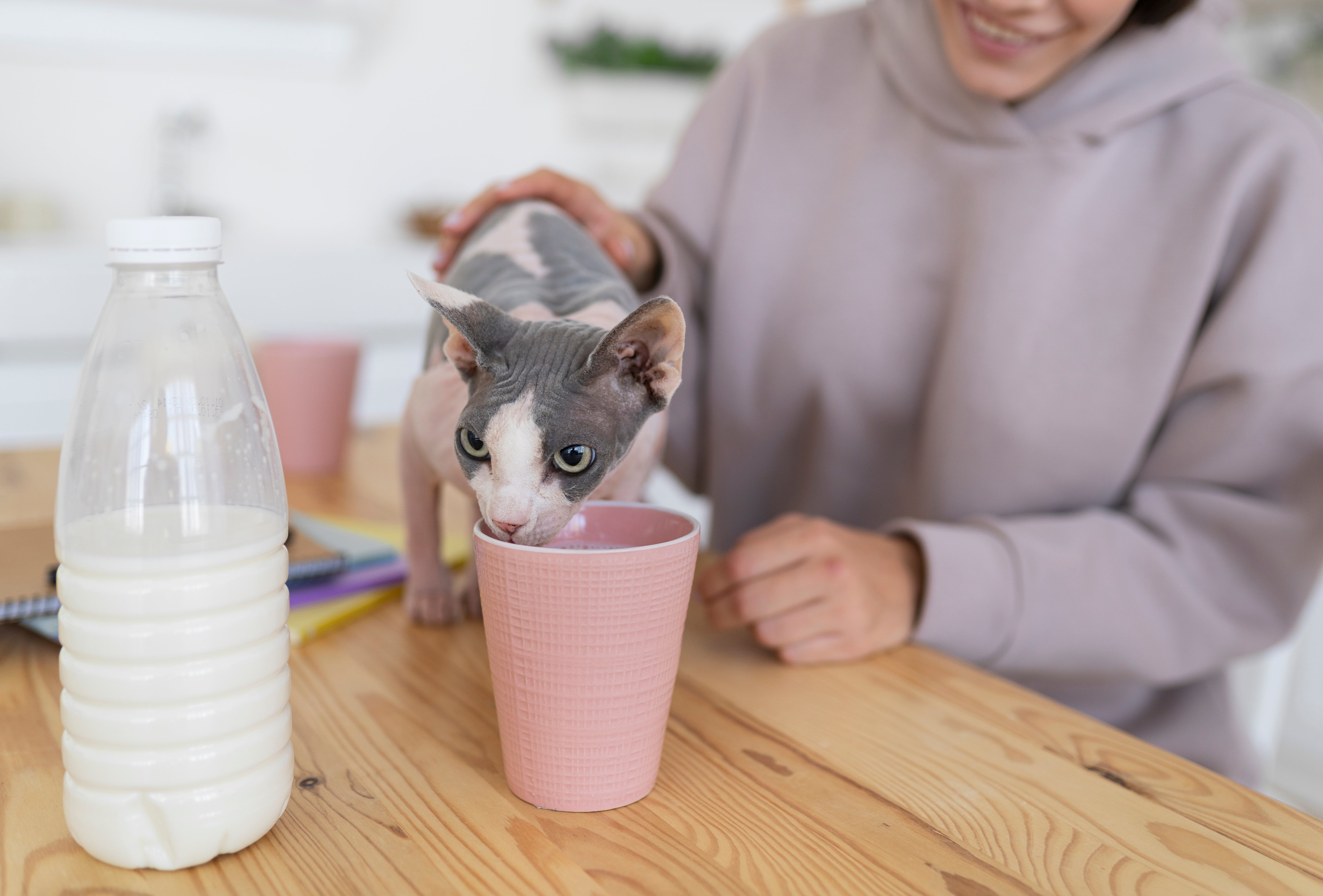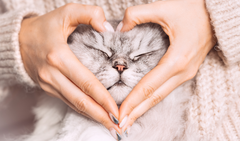Many of us picture a charming scene where a furry feline laps up a dish of cow's milk with satisfaction. However, this long-standing cultural image can lead to digestive problems for our pets. While kittens thrive on their mother's milk, adult cats lose the enzyme lactase as they mature, rendering them lactose intolerant. This inability to process lactose means traditional dairy products—including homogenized milk and goat's milk—often lead to gastrointestinal upset or even gastrointestinal inflammation. It is our collective responsibility as pet parents to understand the risks, provide accurate dietary advice, and ensure that every aspect of the cat's diet meets scientifically sound nutritional needs with a complete and balanced cat food foundation.
The Iconic Image vs. Reality: Why Most Cats Can't Digest Milk
Throughout history, the image of a cat savoring a bowl of cow's milk has been perpetuated through stories and media, but most adult cats are actually lactose intolerant. After kittens transition from mother's milk to a solid food diet, their bodies drastically reduce production of the enzyme lactase, which is essential for breaking down lactose in dairy. The misconception that felines crave traditional dairy products often leads to digestive problems such as vomiting, diarrhea, and gastrointestinal distress when cats are given homogenized milk. To keep our pets happy and healthy, we must distinguish between myth and the reality of cat nutrition.

Understanding Lactose Intolerance in Adult Cats
Lactose intolerance occurs because most cats naturally lose the ability to produce sufficient enzyme lactase after weaning. Without enough lactase, consuming cow's milk or even goat's milk leads to undigested lactose fermenting in their intestines, causing GI upset and gastrointestinal inflammation. Veterinary care is often required when cats suffer from repeated episodes of gastrointestinal upset. This physiological reality highlights the importance of focusing on a cat's unique nutrient needs rather than outdated traditions.
Exploring Dairy and Non-Dairy Milk Alternatives for Cats
While products like lactose-free milk and commercially available cat milk from pet shops or the local pet store seem tempting, they should be seen only as rare treats. Many pet foods promising "milk flavor" are designed to meet feline nutritional needs without causing digestive upset. It's equally misguided to offer plant-based milks like almond milk, soy milk, or oat milks, which do not contain the proper nutrient balance and may cause additional health issues. These beverages are no substitute for complete and balanced cat food developed with input from animal experts and a veterinary team.
Hydration the Right Way: Water over Milk for Cat Health
Cats have a naturally low thirst drive due to their evolutionary adaptation to dry climates, so keeping them hydrated is vital. A cat fountain or pet water fountain with filtered water encourages more frequent drinking and prevents stagnation. Stainless steel food and water bowls are preferable, as they are easy to clean and less likely to harbor bacteria. Hydration using water is best paired with moisture-rich wet food or canned fish to further support urinary and overall health, unlike high-lactose drinks and questionable milk alternatives.

Feline Dietary Choices: From Treats to a Balanced Meal
To meet a cat's full spectrum of feline nutrition and nutritional needs, it's essential to prioritize a complete diet featuring quality protein, fats like omega-3 fatty acids, and proper vitamin D. Occasional use of cat milk, milk replacer, or cat formula is sometimes justified for kittens or sick cats, but these should only be used as directed by animal experts. Commercial treats such as fancy feast creamy delights should never displace a balanced meal. The key is moderation and science-led choices rather than following outdated customs.
The Role of Veterinary Science and Probiotics in Cat Care
Persistent digestive problems, such as chronic diarrhea or GI upset after introducing new foods, require prompt veterinary care. Modern research supports the use of probiotic for improving digestive health and reducing gastrointestinal inflammation. Regular checkups with a veterinary team allow for customized dietary advice, ensuring your cat isn't on a path toward obesity in cats while still meeting all nutrient needs. This approach is critical when considering the cat's hydration, nutrition, and treat selection, as a science-led food strategy can proactively prevent common health issues.
Creating a Healthy Cat Environment: Beyond Food and Drink
Complete care goes beyond food. Clean litter boxes, stimulating cat toys, and secure environments provide not only comfort but also support for instincts like the righting reflex and a healthy vestibular apparatus—necessary for the cat's agility and what's sometimes called their supernatural powers. Accessible pet water fountains, regular cleaning of food and water bowls, and structured feeding times all contribute to a cat's health and wellbeing. When we attend carefully to every aspect of our pet's daily experience, including hydration and proper nutrition, we support excellent night and peripheral vision, mood, and longevity.
Many people imagine a cat contentedly lapping up a bowl of milk, but the reality behind this iconic image is quite different from the popular myth. We commonly associate cats with milk, influenced by stories, advertisements, and countless cartoons. However, offering milk to our feline companions is far more complicated than it seems. In truth, most adult cats are lactose intolerant, and giving them dairy products can result in digestive discomfort or even health issues. In this article, we analyze why cats react differently to milk than many expect, how their digestive system processes dairy, and what safe hydration options exist for our feline friends.
Understanding the Myth: Why Did We Think Cats Love Milk?
The image of the milk-drinking cat likely stems from times when cats lived on farms and had access to fresh dairy. In these rural environments, cats would lap up the cream that rose to the top of raw milk, a richer and fattier portion less likely to cause immediate issues. Over generations, this scene became a cultural fixture, reinforced by books, media, and human assumptions. Yet, as more research surfaced, it became evident that the average household cat cannot tolerate milk as depicted. The nostalgia surrounding this image persists, but pet owners should be well-informed about the actual nutritional needs of modern cats. Accepting the truth about cats and milk helps us foster healthier relationships and prioritize their wellbeing.

The Science Behind Lactose Intolerance in Cats
Lactose is a sugar found in milk, requiring the enzyme lactase for digestion. All kittens initially produce lactase, as their mother's milk is their primary source of nutrition in the early weeks of life. However, after weaning, the production of lactase in most cats significantly decreases. This reduction means that when adult cats consume milk, they cannot efficiently digest lactose. The undigested lactose draws water into the intestine and is fermented by bacteria, leading to symptoms such as diarrhea, gas, and stomach discomfort. Veterinarians routinely encounter cases where well-intentioned cat owners unknowingly upset their pet's digestive balance by offering cow's milk. Thus, understanding this basic biology warns against the casual feeding of dairy to adult felines.
Possible Health Consequences of Giving Cats Milk
Cats that ingest milk beyond kittenhood often suffer from various gastrointestinal problems. While some cats may appear unaffected by small amounts of milk, most will experience issues over time. Diarrhea and stomach pain are the most common reactions, which can lead to dehydration—a dangerous situation, especially for young or elderly cats. Repeated exposure to milk that causes stomach distress can also upset the cat's regular feeding habits, resulting in reduced appetite for nutritionally complete food. In some cases, persistent gastrointestinal upset may also weaken the immune system or exacerbate underlying health conditions. Owners could inadvertently cause harm by mistaking feline curiosity for genuine enjoyment, highlighting the importance of following current veterinary advice.
Are There Any Safe Dairy Alternatives for Cats?
For those who wish to give their cats a special treat reminiscent of the classic milk bowl, there are safer alternatives on the market. Pet stores now offer specially formulated "cat milk" products, which are lactose-free and designed for easier feline digestion. These products allow cats to enjoy the taste and texture of milk without the associated health risks of lactose. Even so, treats of any kind should remain a minor aspect of a cat's diet, and water should always be their primary beverage. If a cat displays any signs of digestive upset following consumption of any dairy, it is wise to discontinue and consult a veterinarian. Responsible cat ownership means prioritizing nutrition backed by scientific understanding rather than tradition or anecdotal beliefs.

Best Practices for Hydrating Cats Safely
The healthiest drink for cats, regardless of age, is fresh, clean water. Cats possess a naturally low thirst drive, which traces back to their evolution as desert-dwelling animals. As a result, ensuring constant access to appealing water sources is essential. Some cats may prefer running water or wider bowls that do not touch their whiskers, increasing their willingness to drink. Providing wet food is another way to promote fluid intake, as it contains a higher moisture content than dry kibbles. By focusing on water and balanced cat diets, owners contribute to optimal digestion, kidney health, and overall wellbeing. Hydration should never rely on milk or milk-based substitutes, as these do not supply the correct nutrients or safety profile for daily consumption.
Conclusion: Making Informed Choices for Feline Health
While the image of a cat drinking milk endures in popular culture, science provides a different perspective. Most cats lose the ability to digest lactose shortly after weaning, causing symptoms and potentially endangering their health if given regular milk. By understanding the root of this widespread myth, embracing evidence-based care, and choosing high-quality, species-appropriate hydration, pet owners uphold their responsibility to their feline companions. Always consult with a veterinarian when in doubt about safe treats or beverages for your cat. By doing so, we foster a healthier, happier bond with our beloved pets—one that leaves outdated myths behind.




















